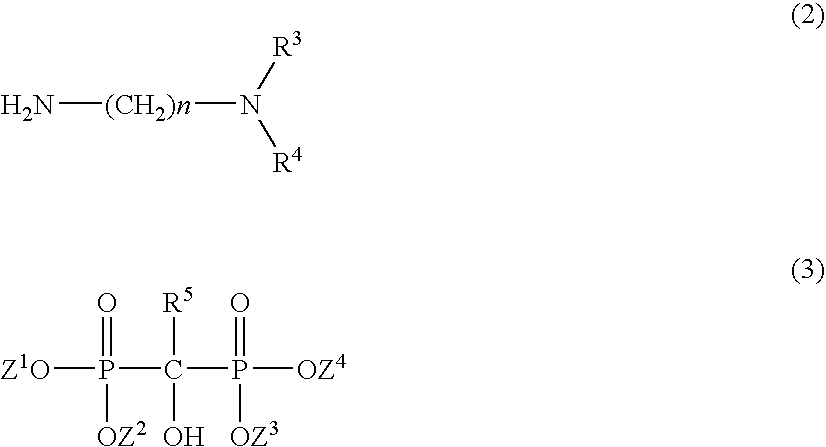Production process for carboxylic amide and derivatives thereof
a production process and technology of carboxylic acid, applied in the preparation of carboxylic acid amides, fatty acid chemical modifications, organic chemistry, etc., can solve the problems of difficult handling in terms of safety, and achieve the effects of good excellent color tone and odor, and good long-term storage stability
- Summary
- Abstract
- Description
- Claims
- Application Information
AI Technical Summary
Benefits of technology
Problems solved by technology
Method used
Image
Examples
example 1
[0060] A four neck flask of one liter equipped with a stirrer, a thermometer and a reflux condenser was charged with 350 g of stearic acid (1.23 mole, NAA 173K, molecular weight: 285, manufactured by Nihon Oil & Fat Corporation) and 0.058 g of a hydroxyethanediphosphonic acid 60% aqueous solution (0.01% based on stearic acid, manufactured by Tokyo Kasei Kogyo Co., Ltd.), and the solution was heated at 80° C. to dissolve stearic acid.
[0061] Then, after substitution with nitrogen (reduced pressure 6.7 kPa→set back to atmospheric pressure by nitrogen) was carried out twice, the temperature was elevated up to 185° C., and 151 g of N,N-dimethyl-1,3-diaminopropane (hereinafter abbreviated as DMAPA, molecular weight: 102, manufactured by Tokyo Kasei Kogyo Co., Ltd.) was dropwise added thereto in 4 hours. The solution was maintained at 190 to 200° C. during dropwise adding, and then it was ripened for 5 hours. The acid value was measured to result in confirming that it was 2.1 mg-KOH / g and...
example 2
[0063] The same four neck flask of one liter equipped with a stirrer, a thermometer and a reflux condenser as in Example 1 described above was charged with 256.5 g of palmitic acid (1.0 mole, NAA 160, molecular weight: 256.5, manufactured by Nihon Oil & Fat Corporation), and it was heated at 80° C. to melt palmitic acid. Then, after substitution with nitrogen (reduced pressure 6.7 kPa→set back to atmospheric pressure by nitrogen) was carried out twice, the temperature was elevated up to 185° C., and 139 g of N,N-diethylaminoethylamine (hereinafter abbreviated as DEAEA, molecular weight: 116, manufactured by Tokyo Kasei Kogyo Co., Ltd.) was dropwise added thereto in 4 hours. The liquid was maintained at 190 to 200° C. during dropwise adding, and then it was ripened for 8 hours. The acid value was measured to result in confirming that it was 3 mg-KOH / g and that an amount of the unreacted fatty acid was 1.5% or less. Then, the pressure was reduced to 2.0 kPa at 190° C., and topping was...
example 3
[0065] The same four neck flask of one liter equipped with a stirrer, a thermometer and a reflux condenser as in Example 1 described above was charged with 350 g of methyl laurate (1.64 mole, Pastel M12, molecular weight: 214, manufactured by Lion Oleochemical Co., Ltd.) and 0.29 g of a hydroxyethanediphosphonic acid 60% aqueous solution (0.05% based on methyl laurate, manufactured by Tokyo Kasei Kogyo Co., Ltd.), and the solution was heated at 80° C. After substitution with nitrogen (reduced pressure 6.7 kPa-set back to atmospheric pressure by nitrogen) was carried out twice, the temperature was elevated up to 185° C., and 201 g of N,N-dimethyl-1,3-diaminopropane (molecular weight: 102, manufactured by Tokyo Kasei Kogyo Co., Ltd.) was dropwise added thereto in 4 hours. The solution was maintained at 190 to 200° C. during dropwise adding, and then it was ripened for 8 hours. An amount of the unreacted methyl ester was measured by means of gas chromatography to result in finding that...
PUM
| Property | Measurement | Unit |
|---|---|---|
| Percent by mass | aaaaa | aaaaa |
| Mass | aaaaa | aaaaa |
| Stability | aaaaa | aaaaa |
Abstract
Description
Claims
Application Information
 Login to View More
Login to View More - R&D
- Intellectual Property
- Life Sciences
- Materials
- Tech Scout
- Unparalleled Data Quality
- Higher Quality Content
- 60% Fewer Hallucinations
Browse by: Latest US Patents, China's latest patents, Technical Efficacy Thesaurus, Application Domain, Technology Topic, Popular Technical Reports.
© 2025 PatSnap. All rights reserved.Legal|Privacy policy|Modern Slavery Act Transparency Statement|Sitemap|About US| Contact US: help@patsnap.com



